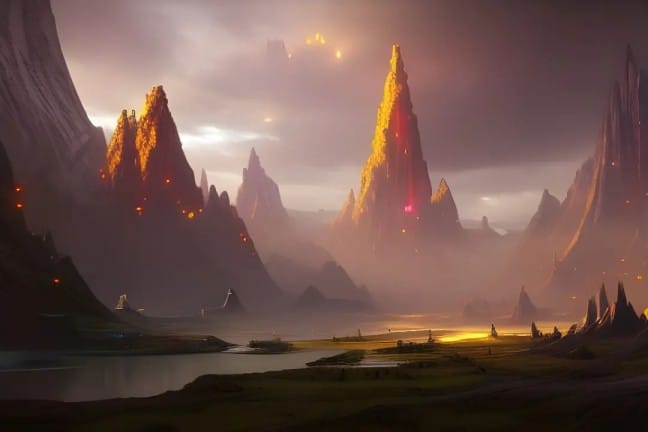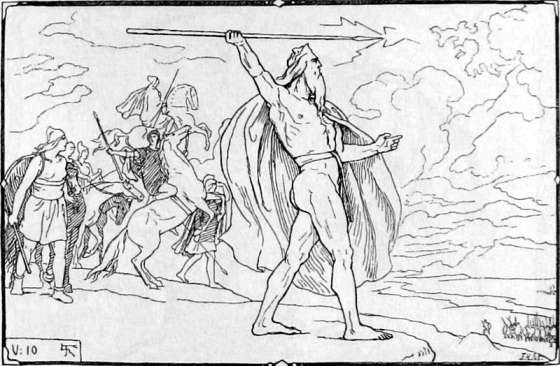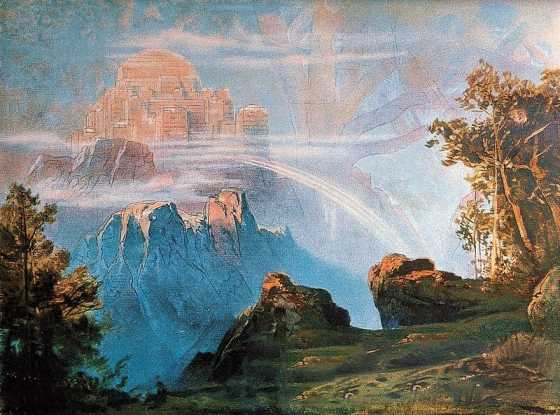High in the sky, where the heavens spread their magnificence, lays the place where gods dwell. Asgard, the home of the Aesir gods. This divine realm is located along the highest lifeblood branches of Yggdrasil, the great tree of the world.
The celestial stronghold of Asgard is surrounded by thick walls that protect it from giants and other various attacks. The mighty All-Father Odin holds court in Asgard. Here he is also joined by the other Aesir gods: Thor, Loki, Frigga, Baldur, Tyr, Heimdall, and others.
Etymology
The name Asgard (Old Norse: Ásgarðr) comes from two words: Firstly āss, which means “god” (referring to the inhabitants of Asgard), that are members of the Aesir tribe). Then secondly garðr, meaning “fence or enclosed area.”
That makes sense and points to the special place on the branches of the world tree Asgard has. In that it is an enclosed, separate place from other realms by its fortifications. So, a meaningful translation of the name would be “enclosure of the gods.” In the same fashion, the realm of the humans was protected by a fence, made from the eyelashes of the giant Ymir. So with that garðr protecting it, and being placed in the middle of the cosmos, the name Midgard (Old Norse Miðgarðr) is fitting.
This also touches upon the symbolism of the chaos that was found outside of the enclosure, or “Utgard”. There you find the realms of the giants and the dwarves, fire and destruction and Hel itself.
Origin and creation of Asgard

The very origin and creation of Asgard, as well as its history, are described in the collection of Norse tales Gylfaginning. Those tales were collected by Snorri Sturluson back in the 13th century. Those stories mention the Swedish king Gylfi who traveled to a place he thought was Asgard (the gods tricked him into thinking so). So Gylfi, disguised as a traveler and calling himself Gangleri, meets three manifestations of Odin. These strange, lordly individuals sit on thrones one above the other. Gylfi questions them and, story by story, they reveal what they know.
This is how Sturluson described Odin’s creation of Asgard in Gylfaginning (The Fooling of Gylfi) – the first part of Prose Edda (chapter 14):
“In the beginning, he established rulers, and bade them ordain fates with him, and give counsel concerning the planning of the town; that was in the place which is called Idavold, in the midst of the town. It was their first work to make that court in which their twelve seats stand, and another, the high seat that All-father himself has.
That house is the best-made of any on earth, and the greatest; without and within, it is all like one piece of gold; men call it Gladsheim. They also made a second hall: that was a shrine that the goddesses had, and it was a very fair house; men call it Vingólf.
Next, they fashioned a house, wherein they placed a forge and made beside a hammer, tongs, and anvil, and using these, all other tools. After this, they forged metal and stone and wood and wrought so abundantly that metal which is called gold, that they had all their household ware and all dishes of gold.”
The Bifrost bridge
Despite being the realm of the Aesir gods in Norse mythology, Asgard is not a focal point of cosmology. This place of unearthly magnitude, beauty, and splendor – though inhabited by supreme gods – is not independent. It is bounded by the life web of Yggdrasil’s branches and owes its vitality to the world tree.
Only one gate leads to the realm of gods. From it the rainbow bridge Bifrost stretches its rays to Midgard, the world of human beings.
By its gates stands the colossal fortress Himinbjörg, the home of Heimdall – watcher and guardian of gods. He is sitting on the edge of the heavens and watches over the bridge because the attacks of giants are always an immense peril. He has the force of the sea and earth on his side, unimaginable eyesight, and is always awake at his watchtower. When invaders are getting close he will warn the gods by blowing in the Gjallarhorn (“Resounding Horn”).
Andlàngr and Vídbláinn
High in the branches of the world tree resides two other heavenly realms. The first one is Andlàngr (“extremely long, wide one”). It is placed somewhere above Asgard. Secondly, and uppermost of all heavens is yet above that, and it is called Vídbláinn (“wide-dark”). The great hall Gimlé is found in this realm. It is a hall covered with gold and is destined to be a shelter for all humans after the world collapses in Ragnarök.
The war between Aesir and Vanir – ruins and resurrection of Asgard

After the world’s creation, one of the first events mentioned in Norse mythology is the war between the Aesir and Vanir. The power of the Aesir is reflected in their strength and the art of warfare. The Vanir however are deities who live in Vanaheim, and their power is primarily reflected in wisdom and the ability to predict the future.
Their clash is described in the Heimskringla sagas, written by Snorri Sturluson sometime around 1230. The Aesir, led by Odin, attacked the Vanir, but they were well prepared for this attack. As is always the case with war and its aftermath, the losses on both sides were devastating.
Eventually, the two tribes of gods agreed to make peace. To seal the peace deal there was an exchange of hostages. The Vanir sent Njörðr and his children Freyr and Freyja to Asgard. In return the Aesir chose Hoenir (old Norse Hœnir) and Mímir in exchange and sent them to Vanaheim.
Later the Vanir would realize they had been tricked when they believed Hoenir was a wise man and had instated him as their leader. In fact, Hoenir was rather dumb and only gave advice after consulting with the very wise Mimir.
In retribution, the Vanir killed Hoenir and also chopped off Mimirs’ head and sent it back to Odin in Asgard. However, recognizing how valuable Mimirs’ advice was, Odin treated it with herbs and spoke magic spells over it, bringing it (the head only) back to life. Installing the head by one of the wells at the foot of Yggdrasil, Mimirsbrunnir, Odin would visit Mimir and drink from the well of wisdom.
The fortification of Asgard
As the realm of the Aesir was left in ruins after the war, they were in need of new fortifications around Asgard. They hired a giant to do this job. Although the giant’s desire for his great deal of labor was an equally great reward – Freyja for his wife – the gods agreed to the bargain. As the giant’s work came close to a finish, the gods had to think of a way to deceive him.
Loki, a wily deceiver, took matters into his own hands, transforming himself into a mare. In this way, he distracted the giant’s horse, which was crucial to his work. Therefore without his horse, the giant couldn’t complete the task and get Freyja as his wife. On the other hand, gods had Asgard almost restored. The giant, realizing this deception, became enraged and attacked the perfidious gods. Misfortunate as he was, he soon ran into Thor – the giant slayer, who swiftly smashed him to smithereens with his mighty Mjölnir.
Loki’s notorious children in Asgard
Three infamous children of the trickster god Loki and giantess Angrboda once were brought to Asgard, but not for long. A prophecy foretold that Loki’s children – the serpent Jörmungandr, great wolf Fenrir, and Hel, “queen of the dead” – would cause the gods of Asgard trouble, so the gods feared them.
By Odin’s order, gods captured the monstrous children in the middle of the night from Jotunheim, the land of the giants where they had lived with their mother, and brought them to Asgard. Odin later tossed Jörmungandr into the sea and, not wanting to kill her, sent Hel into the depths of icebound Niflheim to be the ruler of Helheim. Wanting to keep an eye on Fenrir they kept him in Asgard.
However, he grew so large and menacing that only Tyr was brave enough to feed him. After some time, the gods decided that Fenrir needed to be bound. Dwarfs from Svartalfheim made a magic silk rope called Gleipnir so the gods could bind Fenrir. They tricked him to an island Lyngvi in the middle of Lake Amsvartnir, Tyr losing his one hand in the process. There he would remain bound until Ragnarök..
Places in Asgard
The majority of the Norse pantheon is composed of the Aesir gods, however there are a few Vanir gods as well. Each one of the significant gods had a great hall set in Asgard. In the poem Grímnismál of the Poetic Edda Odin tells the young Agnar about the splendor of Asgard and the halls of the gods.
The greatest one is the almighty Valhalla, the afterlife realm for Odin’s heroes slain in the blaze of battle the einherjar (“army of one”).

Thrudheim (meaning “stronghold”) is the realm of Thor, Odin’s son, god of thunder, sky, and agriculture. His hall is called Bilskirnir, which means “lightning crack”, and has 540 rooms. Thor dwells here with his wife Sif and their daughter Thrud when he is not on his adventures.
Freyja, sister to Freyr lives in a hall called Sessrumnir (Many rooms, or many seats) placed in the field named Fólkvangr (Field of the people).
Odin’s other son Baldur has his beautiful home in Asgard, which is called Breidablik. It is free from everything unclean, because Baldr, “the fairest and best of the gods” lives there.
Baldr’s son, Forseti – the god of justice – also has his hall in Asgard. His home is called Glitnir, and it has pillars of gold and a roof of silver. As the mediator and peacekeeper, Forseti hears the cases and passes judgments in this hall.
Odins’ second great hall Valaskjálf
Valaskjálf is Odin’s great hall where the gods gather. It is located in the central part of Asgard and has a roof made of pure silver. Inside this great hall is the high seat called Hlidskjálf, where the All-Father can see across the entire universe. His wife Frigg also has her own hall in Asgard called Fensalir.
Idavoll is a central plain in Asgard, which the gods often used as a meeting place. There are some of the other central locations in Asgard located. First of which is the meeting hall called Gladsheimr, which contains thirteen high seats for the Aesir gods,. Secondly you can find Vingólf, where the goddesses gather.
The vast field of Vigrid also found its place in Asgard. There the twilight of the gods, the end of the world, and all existence (Ragnarök) will take place.
Valhalla
There are five realms in total where souls of the dead can travel in the afterlife. One is Fólkvangr (the realm of the goddess Freyja, placed in Asgard). Another is Hel (the realm of the goddess Hel). Third is the Realm of Ran (governed by the goddess Ran), some stayed in their Burial Mound (someone’s tomb or grave), and lastly, some went to Valhalla (Odin’s Hall of Heroes).
Deep beyond the glorious gates of Asgard, the all-powerful Valhalla (“Hall of the Slain”) laid its foundations. It is a place that shimmer in the mind of every Viking warrior. Known as it is to be a final resting place after dying bravely in battle. As their name suggests – “chooser of the slain” – the fearless Valkyries are in charge of selecting the best among the fallen warriors. They would join the ranks of the Einherjar, Odin’s army to fight beside him when Ragnarök comes.
Valhalla is a monumental hall with 540 doors. Every single door is so enormous that 800 warriors can go in and out at the same time without colliding with each other. Large golden shields form Valhalla’s roof, and its walls are wooden spears.
Warrior’s day in Valhalla
With the break of dawn the warriors get up and put their armor on. Then they pick up weapons with their sturdy hands, and charge into battle amidst the vast fields of Asgard. They then spend all day there, training and practice the art of war. If a warrior gets injured, loses a limb or even dies during the fight, he would be healed as soon as it got dark. All wounds would disappear as if carried away by a single motion of a hand.
When it gets dark, warriors return from the battlefields to Valhalla to join a never-ending feast. They enjoy eating and drinking as much as they want. They devour the flesh of the gigantic boar Sæhrímnir, prepared by the chef Andhrímnir over an ever-burning flame. The boar gets magically restored to life so the warriors can eat it again the next day.
Warriors drink the most delicious mead from the goat Heidrun. The goat stands on the roof of Valhalla and feeds on the branches of Yggdrasil. With endless streams of delicious mead flowing from her udders, everyone is kept merry and drunk all night long. From the antlers of the deer, Eikthyrnir constantly drips cold water and thus supplies Valhalla and all the other realms with clean and clear water. From its antlers water also drips into the well Hvergelmir, feeding into the mighty rivers Élivágar.
Resurrection of the world
In some interpretations of Ragnarök, at the end of a crucial battle, all nine worlds of Norse mythology will sink deep into the sea. There will be nothing left but the void. So Ragnarök is in that version the end of everything.
In other interpretations, there is a renewal. Gods who survive destruction will visit the area where celestial Asgard once stood. Survivors include the goddesses Frigga, Freyja, Sif, Idunn, and Thor’s daughter Thrud. Some of the gods also survive, among them are Thor’s sons Magni and Modi (who inherit Thor’s mighty hammer). In addition to the sons of Thor, Hermodr, Odin’s sons Vidarr and Váli, and a few others also survive.
Two human beings, a man and a woman called Lif and Lifthrasir (meaning: Life and Vitality), have also survived Ragnarök by hiding in a place Hoddmímis holt (Wood of Hoddmimir). After coming out of hiding, their destiny is now to repopulate the earth so the new life cycle can start. The resurrection of the world is described in the best-known poem of the Poetic Edda – Völuspá:
I see the earth
Rise a second time
From out of the sea,
Waterfalls flow,
And eagles fly overhead,
Hunting for fish
Among the mountain peaks.
The Aesir meet
On Ithavoll
And regard
The bones of the Midgard-serpent,
And there they recall
The great events of Ragnarök
And Odin’s old wisdom.
(The Poetic Edda, translated by Dr. Jackson Crawford)
FAQs about Asgard
Asgard is not a real place, although there are some theories by Norse scholars about where it may be located if it was on Earth. It is one of the nine realms of Norse cosmology and the home of the Aesir gods. All the well-known Norse gods lived there: Odin, Thor, Loki, and Tyr, among others.
Asgard can get translated as the home of the gods. The term (Old Norse: Ásgarðr) derives from two words. The first one is āss, which means “god,” and refers to the inhabitants of Asgard – Aesir gods. The latter is garðr and means “garden,” “yard,” or “isolated, enclosed area.”
Valhalla and Asgard are not the same. Asgard, the home of the gods, is divided into 12 smaller realms. One of those realms is Valhalla, a monumental hall and afterlife realm for Odin’s brave heroes slain in the battle.
Midgard is the realm where Norse mythology placed humans, the Earth. The almighty Odin created it with his brothers Vili and Ve. They slayed primordial giant Ymir and built the world out of his remains. It was first populated by Ask and Embla, from whom all other people descended.
Although it is the realm of the gods, Asgard should not be confused with the notion of heaven in other religions. Asgard is a place where Aesir gods reside. In Norse mythology, there are five other realms to which the souls of the dead can travel in the afterlife.
Featured Image Credit: Richard Wagner, Otto Schenk, via Wikimedia Commons
